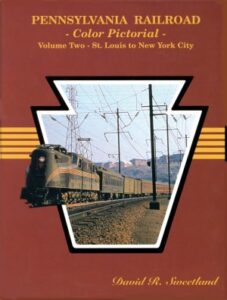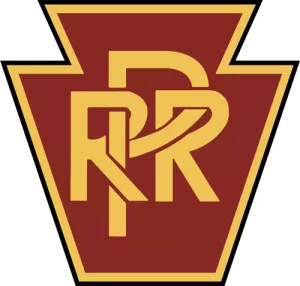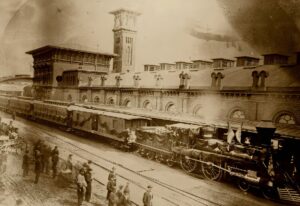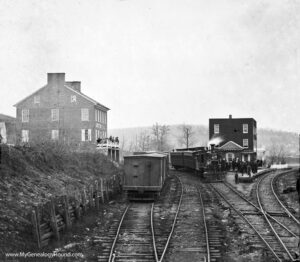
 The Pennsylvania Railroad Company (PRR), known as the “Pennsy,” was a premier American Class I railroad founded in 1846 with its headquarters in Philadelphia, Pennsylvania. It got its name from the state where it originated. In contrast to other major eastern trunk lines, the Pennsylvania Railroad began operations later. A trunk line railroad is a railroad line providing basic nationwide transportation ties within a country or with neighboring countries. The Baltimore and Ohio, Erie, and New York Central Railroads all had origins dating back to the 1820s and early 1830s. The Pennsy emerged from Pennsylvania’s desire to remain economically competitive. It built a meticulously engineered route from Harrisburg to Pittsburgh and grew primarily through acquisitions. At the height of its operation, the PRR managed an extensive network of routes, catered to millions of passengers, and is often celebrated as the most illustrious of American railroads.
The Pennsylvania Railroad Company (PRR), known as the “Pennsy,” was a premier American Class I railroad founded in 1846 with its headquarters in Philadelphia, Pennsylvania. It got its name from the state where it originated. In contrast to other major eastern trunk lines, the Pennsylvania Railroad began operations later. A trunk line railroad is a railroad line providing basic nationwide transportation ties within a country or with neighboring countries. The Baltimore and Ohio, Erie, and New York Central Railroads all had origins dating back to the 1820s and early 1830s. The Pennsy emerged from Pennsylvania’s desire to remain economically competitive. It built a meticulously engineered route from Harrisburg to Pittsburgh and grew primarily through acquisitions. At the height of its operation, the PRR managed an extensive network of routes, catered to millions of passengers, and is often celebrated as the most illustrious of American railroads.
In the early 1840s, Philadelphia’s commercial significance faced threats from two fronts. The increasing trade through the Erie Canal directed a growing volume of commerce from the Central West to the northern seaboard. In addition, the burgeoning Baltimore and Ohio Railroad signaled a significant commercial future for Baltimore, Maryland, potentially eclipsing Philadelphia. The Baltimore and Ohio Company, demonstrating remarkable initiative, sought connections with Pittsburgh to reroute western trade away from eastern Pennsylvania. Additionally, Philadelphia’s financial reputation had been tarnished by recent turmoil. The Panic of 1837, which was the United States Bank’s clash with President Andrew Jackson, its subsequent defeat and failure as a state bank, and the resulting distress within local financial sectors, all contributed to the shift of the nation’s monetary hub to New York.
In 1847, the directors of the Pennsylvania Railroad appointed J Edgar Thomson, an engineer from the Georgia Railroad, to survey and build the line. He selected a path that followed the west bank of the Susquehanna River northward to its meeting with the Juniata River, then along its banks to the foothills of the Allegheny Mountains, culminating at what would become Altoona, Pennsylvania. To cross the mountains, the line ascended a moderate incline for 10 miles to a point where it spanned two mountain ravines by constructing a fill and curving the tracks along a 220-degree bend known as the Horseshoe Curve, which kept the grade below 2 percent. The summit was breached by the 3,612-foot Gallitzin Tunnels, after which the route descended to Johnstown on a gentler slope.
The Pennsylvania Railroad’s charter was expanded on March 23, 1853, permitting the purchase and bond guarantees of railroads in other states, limited by its capital stock percentage. The Pennsy supported several lines to attract more traffic. By 1854’s close, it had acquired stakes in the Ohio and Pennsylvania, Ohio and Indiana, Marietta and Cincinnati, Maysville and Big Sandy, and Springfield, Mount Vernon and Pittsburgh railroads, totaling $1,450,000 (equivalent to $49.2 million in 2023). It also backed the Steubenville and Indiana with a $500,000 bond guarantee. In 1856, it gained a majority interest in the Cumberland Valley Railroad and built more lines in Philadelphia. The Main Line of Public Works was bought in 1857 for $7,500,000 ($245 million in 2023).
The Empire Transportation Company, founded in 1865 by Joseph D Potts, evolved into a multi-modal freight transportation subsidiary of the Pennsylvania Railroad. It possessed oil tanker cars, transporting refined oil primarily for independent refiners during the period of John D Rockefeller’s Standard Oil refinery consolidations in the 1870s. Additionally, the company owned grain freighters on the Great Lakes and oil pipelines in Pennsylvania’s oil-rich areas. In 1877, when it sought to acquire and construct oil refineries, Standard Oil took ownership of the company.
The controlling, non-institutional shareholders of the PRR during the early 1960s were Henry Stryker Taylor, who was a part of the Jacob Bunn business dynasty of Illinois, and Howard Butcher III, a principal in the Philadelphia brokerage house of Butcher and Sherrerd (later Butcher and Singer).
On February 1, 1968, the Pennsylvania Railroad merged with its longtime arch-rival, the New York Central Railroad. The Pennsylvania Railroad absorbed the New York Central and eventually went by the name of Penn Central Transportation Company.
In 1969, the Interstate Commerce Commission (ICC) mandated the inclusion of the struggling New York, New Haven and Hartford Railroad (NH) into the system. A combination of factors such as inflation, mismanagement, severe weather conditions, and the retraction of a $200 million government-backed operating loan led Penn Central to seek bankruptcy protection on June 21, 1970. By May 1971, its passenger services and equipment 
 were handed over to a newly established government-funded entity known as the National Railroad Passenger Corporation, or Amtrak, to alleviate the financial burdens of passenger transport from Penn Central and other railroads. The Penn Central’s rail lines, including the former Pennsylvania Railroad tracks, were transferred to Conrail in 1976, with Amtrak ultimately acquiring the Northeast and Keystone Corridor lines.
were handed over to a newly established government-funded entity known as the National Railroad Passenger Corporation, or Amtrak, to alleviate the financial burdens of passenger transport from Penn Central and other railroads. The Penn Central’s rail lines, including the former Pennsylvania Railroad tracks, were transferred to Conrail in 1976, with Amtrak ultimately acquiring the Northeast and Keystone Corridor lines.


2 Responses to Pennsy